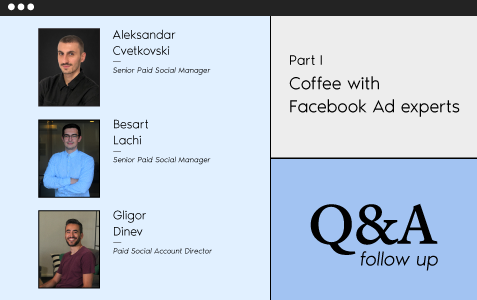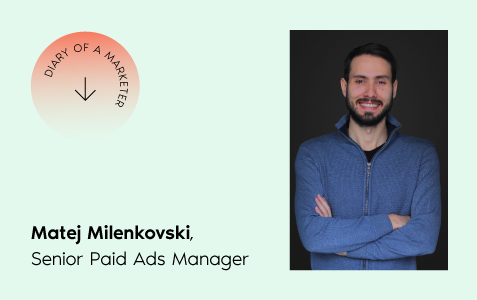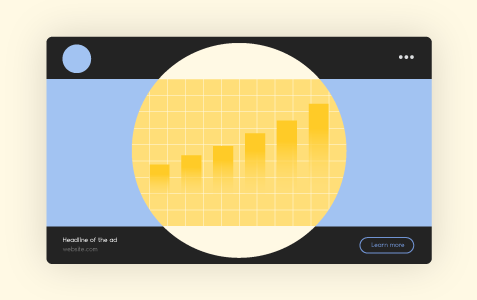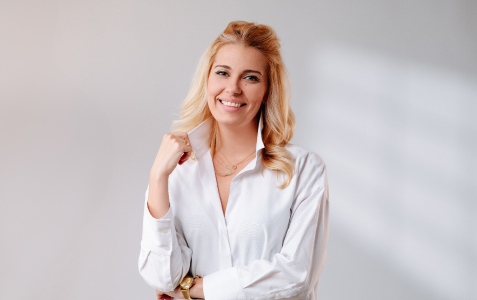We had yet another fantastic coffee-chat with our digital marketers and advertising enthusiasts who wanted to learn more about the Facebook advertising market, the difference between Facebook Ads and Google Ads, different campaigns, and the process of creating and testing ads on Facebook.
This time, our Paid Social Experts – Aleksandar, Besart, Gligor and Andrej answered all of your questions about Facebook Ads. Check out the first part of the follow-up to learn more.
- In the previous Q&A sessions, you discussed that LeanSEM prefers to work with companies that make a significant impact or have the capacity to do so. But what exactly do you mean by ‘impact’? Is it social, economic, socio-economic, or some cultural impact that you are referring to?
Nenad: Our main goal is to grow companies from 0 to 100, and when we say “impact”, we are talking about the economic impact. We could certainly help a small start-up company that doesn’t necessarily have aggressive goals, but it could be a waste of time and our forte doesn’t lie there. Our strength is in growing companies from 5-10K per month to 5-10M per month. Our main job is to make an impact on their economic goals.
On the other hand, if you want your start-up to be successful, you need to make sure you offer something unique and bring value to the market; otherwise, you will not succeed. But of course, we need new companies with fresh ideas and new offers that will help them get to the next level.
Andrej: Ultimately, things are connected. The more they spend, the more impact they have on the environment and their products. The more people use them, the more significant the sociocultural impact.
- When launching campaigns, do you prefer optimizing on ‘Purchases’ right from the start, or go through the whole process with all the other conversion events?
Aleksandar: The short answer would be ‘yes’. When it comes to e-commerce clients, we start with ‘Purchase’ Conversions right away because we want to feed the conversion algorithm with data (which is our ultimate goal from the beginning) so that, in time, it learns how to find the users who would do those Purchase Conversions.
We have tested this with more clients – optimizing for the ultimate goal, which is ‘Purchase’, or some higher funnel events such as ‘Add to cart’, and we have established that optimizing for ‘Purchases’ brings better results.
But there will be times when you’ll need to work with smaller budgets than usual. You’ll notice that you won’t have enough final conversions at the beginning to learn what works and what does not work for the campaign (in the term of audiences, ads, etc.). In that case, you would like to try and optimize for a different event and gather more information about what works and what doesn’t. Once you have that information, you would like to quickly switch to ‘Purchase’ Conversions because Facebook is pretty good at finding the right user.
- What’s your approach for remarketing campaigns, and how much do you spend on them?
Besart: We distinguish between COLD or Prospecting and Remarketing campaigns—the difference between the two lies in the audiences we target. In Prospecting or COLD campaigns, we target audiences that we contact for the first time, while with Remarketing and Retargeting campaigns, we target audiences with whom we have already had contact previously.
Usually, our practice is to focus more on prospecting campaigns (which is also something Facebook representatives suggest), and we spend around 70% of our budgets on COLD and about 30% on Remarketing campaigns.
But everything is relative, and this depends on many things. If we see that COLD does not perform significantly better than Remarketing, there is no point in spending too much on it. Thus, we’d optimize what performs better. But the issue with the Remarketing campaigns is that the Remarketing audiences are tightly connected to the Prospecting audiences. If you do not have enough website visitors, you will have nothing to retarget. So there has to be a balance between these two audiences for a successful campaign.
In terms of which audiences we use in Retargeting campaigns, the most common are website visitors, view content (an audience that has seen or visited a particular product on the website), and past purchasers.
We should also mention the iOS 14 update and its effect on Facebook marketing, especially the Remarketing campaigns. The changes that will occur due to this Apple update will make us less reliant on Pixel-based Remarketing audiences; instead, we want to focus more on Remarketing audiences that we could target despite the update (video viewers, past purchasers, or people who have left an email or our leads).
- What is your process for creating and testing Facebook Ads?
Gligor: There is no one single process. You need to test everything. But if you want to get to a process faster, start with what you have. The previous data will give you great insight into what performs well and what triggers the users. Of course, you will need to do User Persona research too. That will help you learn how to position yourself in front of the user and what you need to test next.
This is how the process begins but does not end here – it’s a cycle. Before you start launching any ad, my tip is to spend a lot of time researching the User Persona, learn how to speak like the user, and test different positionings, not just different variations of the same concept.
For example, if you have an e-commerce client, you can focus on a direct offer or discount as a concept. But if you want to communicate something more related to the brand, you can test completely different positioning in front of the user. Then you can try different formats, such as image, video, carousel, Insta story, collection ad, etc.).
But the testing does not end here. If a particular video ad does not perform well for you, it does not mean that you should stop here; maybe the same concept will work in another format. While doing all these things, it is essential to pay attention to what is happening “behind the scenes” and draw conclusions. Based on those conclusions, you will develop new concepts that you will want to test later on. It often happens that you have several winning ads, and they will be bringing all the volume and all the revue. What you want is to beat these ads. You can read more about it in this article: How to beat your top Facebook Ad? Part 1 and Part 2.
- What type of ads perform best on Facebook, and how do Facebook Ad campaigns differ from others, such as Google Ads?
Alexander: There is no right answer to that question because it depends on many variables: the type of product you sell, the brand, what kind of story you want to tell through different formats. The latter is probably the most important variable.
Performance may not depend on whether you serve an image, a video, or a carousel, but it does depend on what you communicate through the ad. Once you have tested the various positionings (the different stories that you try to “sell” to the user), you will see what works best for your client. It does not mean that if the video format performs best, you should only go with that format.
There are situations when different formats complement each other. For example, users sees your video and later see an image; lastly, they see a carousel ad and decide to buy. This doesn’t mean that the carousel ad performed the best; perhaps the combination of the three made them make a purchase. You should try all possible formats and keep testing them for each subsequent concept you want to introduce.
From our experience with e-commerce customers in the Remarketing segment, carousels work best. This is because the users are already familiar with the brand; they had probably visited the website; they were scrolling through the products, and in fact, the carousel shows them the products they were checking out.
Andrej: In terms of how they differ from Google Ads, we need to remember that Google Ads show up only after the user had searched for a particular thing they need. Facebook requires a different mindset. Here we intercept the users when they are casually scrolling through Facebook. Therefore, the ad itself should be more catchy and attention grabbing, which is a totally different approach – we have audience-based targeting on Facebook vs. keyword-based targeting on Google. For Google Ads, we buy specific keywords that people use and therefore the intention is different.
- What is the most complicated campaign you have ever worked on, and how much time did it take you to create it?
Andrej: There are no complicated campaigns for Google, but there are complicated clients. Some customers have over 100 different products; they use different languages in different countries, so all ads should be translated. There are complex accounts of some Enterprise Companies that are worldwide and spend millions of dollars. This is where the complexity lies; otherwise, the campaigns’ structures are almost always the same.
Aleksandar: Same with Facebook, the setup is the same: you choose a Conversion event – you choose your audience – you create the ad. But of course, it also depends on how many products the client offers, how many languages the ad will have to be translated in, etc.
- Based on your experience, which types of Facebook and Instagram ads show the best results? Do video ads stand out from other formats?
Aleksandar: As we already mentioned, there is no way to tell which format is the best, but our experience has shown that the video format gets the most engagement. Image ads, however, get a better click-through rate. One hypothesis is that the user will be motivated to click on the image faster because they don’t have to wait and watch the video. Carousel ads can also get a great engagement rate, as it forces the user to scroll through the products.
- The budget distribution (80% of the revenue comes from 20% of the customers) suggests that ‘Remarketing’ would be more effective than attracting new customers. So, why is the focus on attracting new customers bigger?
Andrej: If the client has a very small budget, of course, they should start with Remarketing first. But as the budget and the spend increase, they won’t need to spend as much on Remarketing; instead, the more significant part of the budget will go towards the Prospecting segment.
Besart: It is essential not to make any assumptions; everything should be tested. It is very likely that COLD may work much better for a specific customer than Remarketing, in which case we will have to focus much more than 80% on COLD. For other customers, it may be the other way around.
- How long does it take to gather all the data before you can make an informed decision that something works compared to other tested ads? If you do two experiments in the same campaign and see that one of them performs better, should you stop the one that doesn’t perform just as well?
Andrej: The length of the process depends on the account, the industry, etc. I would not recommend focusing on the duration of the test but instead, focus on the statistical confidence. We follow this rule where, if we see a certain number of conversions and we see the same difference after seven days, it proves to us that it has performed better. But if the difference is smaller, we give it another week.
The issue here is how the experiment itself is implemented. Sometimes you do not want to pause the old winning ad. In these cases, we do a particular experimental campaign, a pre-test where we’d use 10-20% of the total budget so that we avoid any significant risks.
However, when a campaign/ad set/ad doesn’t perform well, you should pause it and you try to improve the perfromance by finding new winners, which can be a modification of the existing audiences/ads or brand new concepts.
_____________________________________________________________________________
Sounds interesting? Stay tuned for the second part of the ‘Coffee with Facebook Ads Experts’!
In the meantime, we’d be happy to have you in our Facebook Group PPC Addicts, where we discuss PPC and Digital Marketing experiments, experiences and news.




